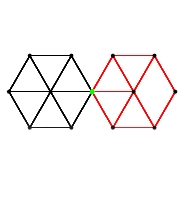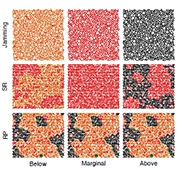
Jamming the result of special self-organisation
Materials that are built up from individual granules exhibit a special phenomenon called ‘jamming’. With research into the nature of this phenomenon, a team of scientists led by Leiden physicist Prof. Martin van Hecke has made it to the cover of the prominent journal Physical Review Letters. ‘Jammed systems organise themselves in a very special way,’ says van Hecke.

A large number of granules can behave in a strange way. If the density of the granules is high enough, they resist pressure as if together they formed a solid substance. At the same time they can slide against each other. In this way a pile of sand can support a car, while together separate bubbles form a mass of sea foam. This transition from loose to solid is called jamming.
Springs
Van Hecke has known for years that jamming was a special phenomenon. He has been conducting research on the phenomenon since 2002. It was already known that factors such as pressure and the nature of granules influenced the transition from loose to solid. But what exactly happens at the border between these two states was a mystery. A study conducted by van Hecke with his colleagues at TU Eindhoven and Arizona State University was intended to shed light on this issue. They accomplished this with a relatively simple computer experiment.
In order to simulate a system of little balls, they tied a thousand movable points together with springs. If enough springs (black lines in the illustration) pull on a juncture (black ball), it stays rigidly immobile and forms a rigid, solid cluster together with its neighbours. If you remove a spring, the cluster remains rigid, but is no longer as solid (black balls, red lines). If you remove an additional spring, the cluster loses its rigidity. Finally, a juncture between two or more solid clusters acts as a hinge (green ball).

In one fell swoop
Using this network, the researchers observed three different situations, with a jammed system and a chaotic system at the two extremes. In a chaotic system (bottom row) the springs have been placed randomly. A patchwork of rigid and loose pieces is created. If you remove a random spring (left-hand image), the system becomes a bit looser, whereas if you add a spring (right-hand image) it becomes a bit more rigid. So there’s nothing particularly special going on.
But if the system is ‘jammed’ (top row), something completely different happens. A situation comes about in which every individual spring is needed to maintain the rigidity of the whole system (middle picture). If you add a random spring, all the springs turn black (e.g. they become subject to tension) and the network maintains its rigidity. If you remove a random spring, the entire system loses its rigidity in one fell swoop.
Self-organisation
When the images emerged from the simulation, van Hecke had a true ‘eureka’ moment. ‘We knew that a jammed system was special, but not that there would be such a stark difference. My colleague Mike Thorpe was so surprised he fell out of his seat.’ The main thing that the discovery shows is that jammed systems are created by means of a very special type of self-organisation. But exactly how that organisation comes about is a big question. ‘That’s frustrating and intriguing at the same time,’ says van Hecke.
These results are generated by an algorithm, but after years of research into jamming, applications can now be envisioned. In addition to basic research, van Hecke also does work in experimental physics. These activities resulted in a 3D-printed material that can switch between completely different mechanical properties. Van Hecke’s work on this topic was published in Physical Review Letters late last year. One application van Hecke can think of is in shock absorbers that could be used in items such as shoes, but he also mentions an even more exciting application: ‘impalpability cloaks’.
Links
Article: Rigidity Loss in Disordered Systems: Three Scenarios Wouter G. Ellenbroek, Varda F. Hagh, Avishek Kumar, M. F. Thorpe, and Martin van Hecke Phys. Rev. Lett. 114, 135501 – Published 1 April 2015
